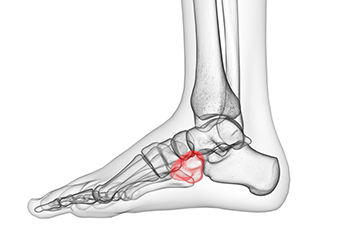 The cuboid bone is one of seven tarsal bones in the foot and is found between the fourth and fifth toes. The medical condition that is known as cuboid syndrome can produce pain in the outside of the foot, and it can be difficult to walk. It can occur as a result of a foot injury that can include twisting the ankle, or unexpectedly stepping off a curb. Additionally, repetitive stress on the foot may lead to cuboid syndrome. Some patients develop this ailment from not stretching adequately before a workout, or it may happen from performing physical activities on uneven surfaces. It is beneficial to stop the activity that caused this syndrome, and it can help to perform specific stretching techniques which may accelerate the healing process. Please consult with a podiatrist if you would like more information about cuboid syndrome.
The cuboid bone is one of seven tarsal bones in the foot and is found between the fourth and fifth toes. The medical condition that is known as cuboid syndrome can produce pain in the outside of the foot, and it can be difficult to walk. It can occur as a result of a foot injury that can include twisting the ankle, or unexpectedly stepping off a curb. Additionally, repetitive stress on the foot may lead to cuboid syndrome. Some patients develop this ailment from not stretching adequately before a workout, or it may happen from performing physical activities on uneven surfaces. It is beneficial to stop the activity that caused this syndrome, and it can help to perform specific stretching techniques which may accelerate the healing process. Please consult with a podiatrist if you would like more information about cuboid syndrome.
Cuboid syndrome, also known as cuboid subluxation, occurs when the joints and ligaments near the cuboid bone in the foot become torn. If you have cuboid syndrome, consult with Jim Maxka, DPM from South Penn Foot & Ankle Associates. Our doctor will assess your condition and provide you with quality foot and ankle treatment.
Cuboid syndrome is a common cause of lateral foot pain, which is pain on the outside of the foot. The condition may happen suddenly due to an ankle sprain, or it may develop slowly overtime from repetitive tension through the bone and surrounding structures.
Causes
The most common causes of cuboid syndrome include:
- Injury – The most common cause of this ailment is an ankle sprain.
- Repetitive Strain – Tension placed through the peroneus longus muscle from repetitive activities such as jumping and running may cause excessive traction on the bone causing it to sublux.
- Altered Foot Biomechanics – Most people suffering from cuboid subluxation have flat feet.
Symptoms
A common symptom of cuboid syndrome is pain along the outside of the foot which can be felt in the ankle and toes. This pain may create walking difficulties and may cause those with the condition to walk with a limp.
Diagnosis
Diagnosis of cuboid syndrome is often difficult, and it is often misdiagnosed. X-rays, MRIs and CT scans often fail to properly show the cuboid subluxation. Although there isn’t a specific test used to diagnose cuboid syndrome, your podiatrist will usually check if pain is felt while pressing firmly on the cuboid bone of your foot.
Treatment
Just as the range of causes varies widely, so do treatments. Some more common treatments are ice therapy, rest, exercise, taping, and orthotics.
If you have any questions, please feel free to contact our office located in Hanover, PA . We offer the newest diagnostic and treatment technologies for all your foot care needs.
